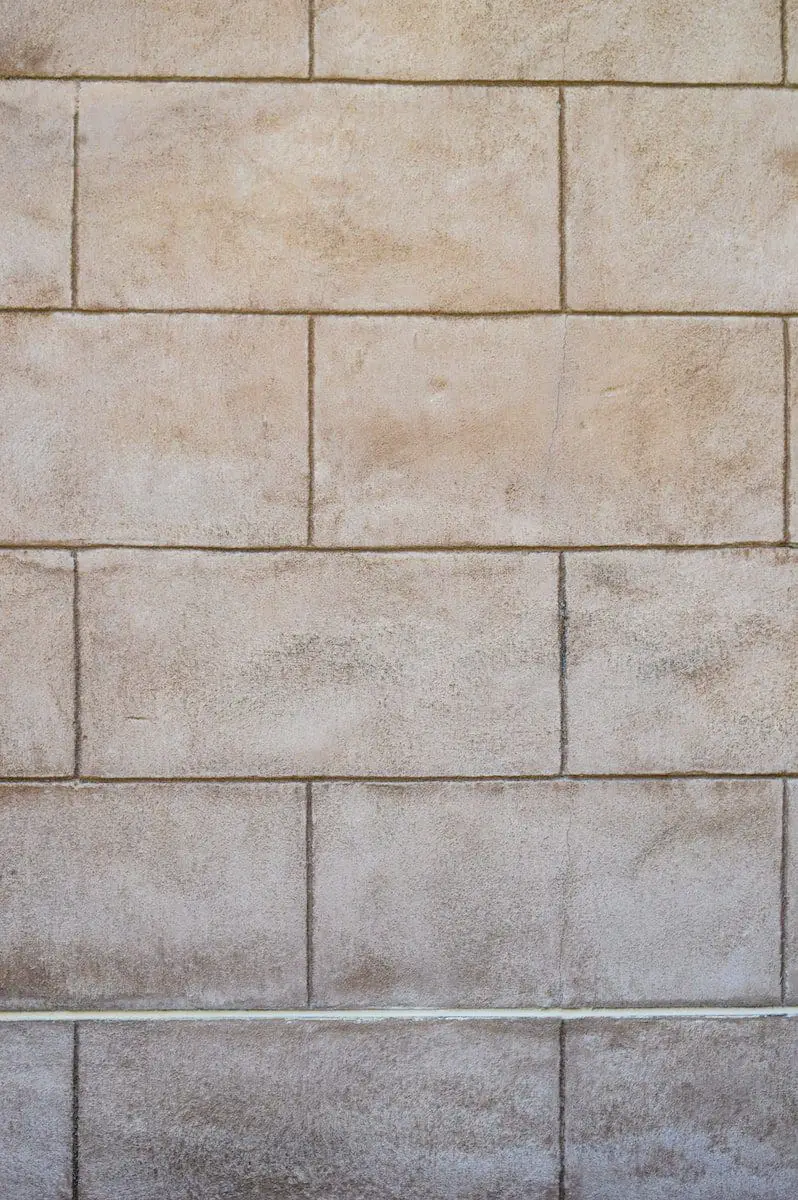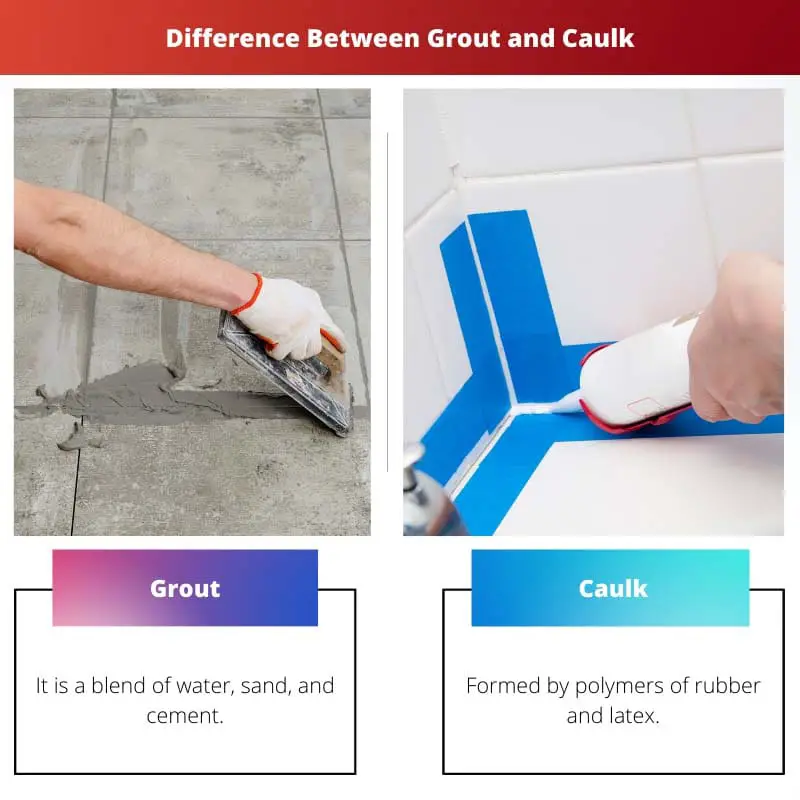Ensuring the tiles are in place and stay durable for a long time, and fixing the water seepage from nooks and corners, may be tedious and stressful. Grout and caulk are household essentials available in the market.
They ensure to keep the stress at bay. These sealants are remarkable in usage, and both grout and caulk have different properties and utilities.
Key Takeaways
- Grout is a cement-based mixture, ideal for filling gaps between tiles and ensuring a uniform appearance.
- Caulk is a flexible, waterproof sealant used to seal joints and gaps around tubs, sinks, and windows.
- Grout is not waterproof, while caulk provides a water-resistant barrier, preventing moisture penetration and damage.
Grout vs Caulk
The difference between grout and caulk is that grout is a mixture of cement, water, and sand. Utilized to fill the crevices, it is not waterproof. The tile projects use cement-based grout. Caulk is a thick substance of polymers. It is flexible, waterproof, and prevents leaks around the sink or shower area.

Grout is a blend of cement, sand, and water. It fills the space between tiles and ensures it does not chip. Most grout is porous and must be sealed immediately to prevent mould or mildew buildup.
There are different types of grout based on the usage and materials utilized.
Caulk is a rubbery material available in a gun format for easy usage. It can be applied on different surfaces at the same time as a sealant to prevent water leakage. Caulk could get utilized on doors and windows as a waterproofing device.
Caulk is an excellent application on small holes or gaps to keep rodents or insects at bay.
Comparison Table
| Parameters of Comparison | Grout | Caulk |
|---|---|---|
| Material | It is a blend of water, sand, and cement. | Formed by polymers of rubber and latex. |
| Application | It is used linking tiles to fill in the gap. | It can link different surface substances together and plug leakage. |
| Strength | It is strong and durable. | It is less strong and must be utilized often. |
| Waterproof | Only grout-epoxy is waterproof. | It is waterproof. |
| Availability | A porous form of substance paste is available after blending. | It is in a gun which is handy to use. |
What is a Grout?
Grout is a dry masonry product. It needs mixing with water to stimulate the gluey properties. It becomes rock-hard when the grout cures. The spaces between the tiles get glued with the usage of grout.
The grout ensures the tiles are in place and the edges do not chip. It gets utilized on a horizontal or vertical surface. Grout is thick and porous, and used in areas that require waterproofing or airtight could lead to issues.
There is epoxy-based and cement-based grout.
The cement-based is popular as it is pocket-friendly. The flexibility is low, and comes in sanded or unsanded versions.
The usage depends on the width of the joint. The unsanded grout is best for thinner joints to create a smoother surface and strong bond. The sanded grout is preferable for wider joints.
There could be an issue as the sanded grout could scratch the marble or glass surface. The unsanded version is best for soft, natural stone.
Epoxy grout is expensive and hence less popular among home buyers. It is flexible and has waterproof properties. Ideal for usage as kitchen counters, floors, and bathrooms. Considerably stronger than cement-based grout but less malleable than caulk.
Grout application is through the float (moving through the surface of the water) and then wiping the excessive residue.
Grout is versatile and applicable to various surface materials. Using planes at a 90* angle and with different blended materials is impossible.
To maintain and protect grout, clean the floor with a dry towel or vacuum to remove dirty water. While applying the cleaner, let it soak on the surface for a few minutes to disperse the dirt.

What is Caulk?
Caulk is a waterproof joint sealing material. Caulk is a blend of polymers like latex, acrylic, and rubber, and these polymers make the sealant flexible, airtight, and waterproof. As it is lesser secure than grout, the application of caulk gets frequent.
Caulk is adaptable and applicable in building materials like sinks, windows, and doors. It can seal the joint between windows and doors to avoid water penetration.
Utilizing caulk in 90* planes is common but cannot replace grout or large-scale projects. Caulk is applied through the caulk gun, ready to use an easy squeeze tube. Caulk comes in different types, like silicone, latex, and a mixture of silicone and latex.
Types of Caulk:
- Silicone caulk-It is the most durable and flexible, best suited for the waterproof surface and gaps which contract and expand. Best suited for outdoor application as it can withstand extreme temperatures. It comes in clear color or neutral shade painting on it is not advisable.
- Latex caulk-It is favoured and easy to apply. It is effortlessly washable with soap and water. You can paint over it to match the ambience.
- Siliconized acrylic latex-It is easier to apply as compared to silicone caulk. Application in both indoors and outdoors, and easily used on wood, stone, and bricks. Weatherproofing of windows and doors can get done.
- Speciality-It gets specified for a particular product. It can be for indoor, outdoor, specific surface material, adhesive, or nonadhesive. Check the label before buying, as the product is specific about usage.
To maintain caulk, we must ensure the surface is dry. We must ensure there is no mildew or mould. Checking the bathroom will help prompt action.

Main Differences Between Grout and Caulk
- Grout is a powder that is later mixed with water and utilized. Caulk is a waterproof sealant available in a gun.
- Grout application is better for interstice to ensure the tile stays intact and does not chip. Caulk application is between different materials.
- Grout is either cement or epoxy-based. Caulk is a blend of latex, rubber, and acrylic polymers.
- Grout application is for long-lasting use. Caulk tends to be less secure and needs a constant check.
- Only epoxy grout is waterproof. Caulk is waterproof.

- https://patents.google.com/patent/USD606375S1/en
- https://www.spiedigitallibrary.org/conference-proceedings-of-spie/10169/101692V/Nondestructive-spectroscopic-characterization-of-building-materials/10.1117/12.2261886.short

This article is extremely educative. I will have to reread a few times to completely understand everything.
It looks like knowing the difference between the two might save a lot of people a great deal of trouble. The details are very informative.
Yes, and the author has pointed out their properties explicitly, which is very helpful.
I would have to say that this article’s information is not very thorough.
The comparison table helped in comprehending their respective attributes.
This is very easy to understand and the knowledge gained is priceless.
It is not as simple as it seems, and the content is filled with jargon.
I agree that it is clear and to the point.
The difference between both grout and caulk is indispensable. It is very enlightening.
The content is really beneficial and something I was not aware of. Grout and caulk are two terms that I will remember from now on.